#the claim is that there was objectively (PROVABLY) inspiration and influence from it
Explore tagged Tumblr posts
Note
The Lion King wasn’t a ripoff of Kimba.
“There's a common claim that The Lion King (1994) started life as a Kimba the White Lion remake, but they were declined the rights and instead opted to "rip off" the series. There's no proof of such an agreement ever being attempted. Concept art of a white cub exists, but it is from the King of the Jungle stage of development where none of the other Kimba similarities existed. It doesn't help that Matthew Broderick agreed to be in the movie expressly because he thought it was a Kimba adaptation (which is frequently misinterpreted as him being told it was a Kimba adaptation, rather than a misunderstanding on his part).
The supposed similarities between Lion King and Kimba are themselves an example of this. Anybody who's ever watched both can tell you that the similarities are surface-level and superficial at best. While it's possible that some people who worked on Lion King were consciously or unconsciously influenced by Kimba, the idea of there being enough similarities to call the former a ripoff of the latter stems from ignorance and flawed, biased sources.
Additionally the urban legend didn't actually start in Japan, contrary to what even some published authors have claimed, but in the United States. The Tezuka estate and production group were both adamant since the first release of Lion King that any similarities between it and Kimba were harmless coincidences due to both series drawing from some of the same pool of African wildlife and tropes”
you dont have to shill for disney on here man its ok theyre not gonna pay u anything
#i know its not a one for one copy lmao i watched kimba#im not mad about an abstract thing im not familiar with just bc its disney im mad because i LOVED kimba#the claim is that there was objectively (PROVABLY) inspiration and influence from it#in both the conception and design levels of the lion king#which were never acknowledged and in fact disney has consistently gone out of their way to shut down even talking about it#if they were just similar by accident disney wouldnt give a shit#and the tezuka estate didnt litigate because its not worth trying with disney over what they Can claim was just inspiration#but have said they did feel an acknowledgement would have been appropriate#OH i just realised this whole thing is in quotes with no indication of YOUR source.#im saying all this in tags bc my memory is bad and i dont have sources on hand#but like did u just google 'is lion king a ripoff' and copy paste the first result. lmao.#a
0 notes
Text
Cernunnos - A Confusion of Aspects
Introduction
This was supposed to be a simple bit of research that I was going to do as a devotional act to Cernunnos, but over the course of the night I kept encountering the same dead ends that pointed to the same singular source of misinformation. So do not expect this to be entirely objective.
Let's begin with a simple question: Who is Cernunnos?
A Gallic deity, with difficult to trace roots. Depicted sparingly, there is debate on whether or not various depictions can actually be attributed to him. Particularly, one of the most famous supposed depictions – the Gundestrup Cauldron – has been theorized by Celtic scholar John Matthews to depict a Shaman and not the god himself, according to his book The Celtic Shaman. Depiction variation and debate is not uncommon in discussion of older religions and cultures, particularly when Romanization and Christian censorship were at play. Not to mention Wiccan appropriation and repurposing of beliefs without regard for earlier context.
Others have made fantastic deep dives into potential depictions and discussed them at length, and I am no historical scholar, so I have little to add in this case. I highly recommend the essay The gods of Gaul: Cernunnos by @mask131 [1] for a piece regarding depictions through history.
Upon reading the previous essay, I was inspired to dig deeper into Cernunnos, from historical contexts to meditating on my own UPG via my connection with him. My own connection with him was something that happened casually over time, ranging from dreamlike interactions to conversing directly through divination. I am an incarnate Fae, and worship him as the King of the Fae, in addition to other aspects and epithets such as:
Cernunnos
King of the Fae
Master of the Sacrificial Hunt, The Horned God, and other Wiccan Concepts
Master of the Wild Hunt
Pan
The Green Man
Herne the Hunter
This list is influenced by a resource post of druidry.org[2], but I will be researching each of these titles for further insights into their sources and how they do or do not connect to my own practice ahead.
[1] mask131, Tumblr
[2] https://druidry.org/resources/cernnunos - this is not a reliable resource
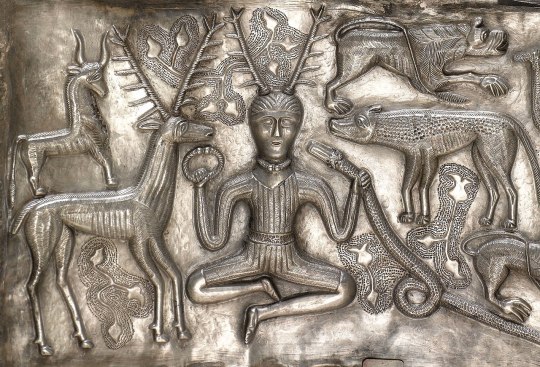
^ Cernunnos depiction on the Gundestrup Cauldron
Cernunnos
As learned in the previously linked essay, the name “Cernunnos” originates from the “Pillar of the Nautes” or the “Pillar of the Boatmen”, where the name is placed directly above a depiction of an antlered figure on the Block of Four Divinities[3] alongside the deity Smertrios. Many Gaul artifacts can be found in French museums. The Pillar of the Boatmen is attributed as a Roman-era inscription[4], so that gives us only enough information to hypothesize.
My takeaway from this is that the name Cernunnos is a modern approximation because of lacking, provable historical records, but rather serves a purpose as a modern placeholder. I came across information claiming that worship of Cernunnos as a deity was brought into modern belief by neo-pagans and popularized by Wiccans, particularly through Margaret Murray’s writings. During her studies of folklore in the early 20th century she put together a Witch-cult hypothesis that stated how a variety of horned deities were aspects of a “proto-horned god”[5]. In addition, this belief was adopted by Gerald Gardner and formed the basis of the concept of the Horned God within Wicca.[6]
“Sometimes also known as Carnonos, his name has firm Proto-Indo-European origins. It stems from the PIE word *k̑r̥no-, and is thus cognate to Germanic *hurnaz and Latin cornu, all meaning “horn”. In the Celtic Gaulish language, this word was karnon, and the connection with the name of Cernunnos is clear - it reflects the deity’s stag antlers, growing from his head. Thus, Cernunnos literally means “the horned one”.”[7]
Gallic history is sparse and difficult to pin down due to a lack of written records or literature. Multitudes of visual depictions dating from the Roman era have been attributed to Cernunnos by Archaeologists, having been retrieved from northern Gaul. These depictions are hypothesized to be this deity or others of similar archetypes. In addition, sites tend to use the words “Gallic” and “Gaelic” semi-interchangeably, despite the regional difference. Gael meaning a Celtic tribe from modern Ireland-Scotland, and Gaul meaning a tribe located in modern France. There is speculation that Cernunnos was a proto-Celtic deity, and could have had roots in any or all Celtic practices and beyond, but that is speculation because there is a lack of evidence to support the theory in any substantial direction.
[3] Name sourced from Athena Review, Vol. 4, No. 2, which also sources Huchard, V. (ed) Archéologica. 2003. “Le Pilier des Nautes Retrouvé. Histoire d’une Métamorphose.” Dijon, France. Éditions Faton S.A
[4] An observation attributed to Hatt, Jean-Jacques who recorded that the artifact was originally erected in 1st century AD.
[5] Margaret Murray, The God of the Witches
[6] Kathleen Sheppard Forced into the Fringes: Margaret Murray’s Witch-cult Hypothesis 21 April 2017
[7] According to Aleksa Vučković via ancient-origins.net
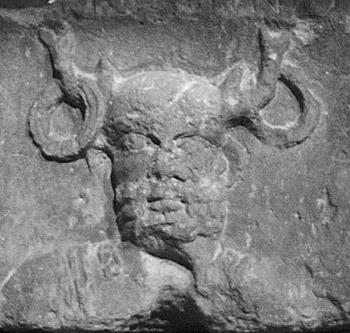
^Cernunnos's face as depicted of the Pillar of the Boatmen
King of the Fae - UPG
This title is predominantly UPG and relates to my own existence as an incarnate fae.
I find him similar but above other more location-based wild gods, beings like boar lords, and other guardians and rulers of nature. There is a loose hierarchy within fae politics, for lack of a better word, that is predominantly power based. Not as in subjugation over other beings, but rather quantified by expanse of control or domains. Finding the words for this section proves difficult, but he is simply above all of us, with a connection to all Fae. Cernunnos does not view himself as better than any of his subjects, he is not preoccupied with anything like that.
Does this title equate him with the concept of Oberon? No, I don’t believe so. He also exists outside of the seasonal courts, as he goes through a physical shift with the seasons instead of remaining in one form.
Master of the Sacrificial Hunt & The Horned God
Many modern depictions and associations with Cernunnos took their form via Wicca, as previously mentioned. The now heavily discounted Witch-cult hypothesis led to the adopting of the name as a common main aspect of Wicca’s concept of the Divine Masculine or the Horned God that absorbed many horned deities into one being, losing their individual status and becoming “aspects” of a central pillar. This is a theme often seen within Wicca and expands to their depiction of a central Divine Feminine deity as well, the pair often referred to as The Lord and The Lady. This is a simplification that I do not agree with. The epithet “Master of the Sacrificial Hunt” is unable to be sourced beyond the previous essay on Druidry.com and a repost of the same write-up on witchesofthecraft.com, so this title isn’t possible to verify. Although, mentions of Cernunnos identify him as a being that has a seasonal cycle of death and rebirth, which this epithet may be indicating. This belief appears to also have its basis within Wicca and lacks historical evidence. To quote from Wikipedia, “Within the Wiccan tradition, the Horned God reflects the seasons of the year in an annual cycle of life, death and rebirth
and his imagery is a blend of the Gaulish god Cernunnos, the Greek god Pan, The Green Man motif, and various other horned spirit imagery.”[8][9]
While I am large proponent of UPG, I do not abide by stating such concepts as strict facts. I will explore this further in future sections.
[8] Farrar, Stewart & Janet Eight Sabbats for Witches
[9] Doreen Valiente The Rebirth of Witchcraft pg 52-53

^The plaque I'm sure we've all seen in our local metaphysical store
Master of the Wild Hunt
The Wild Hunt is a concept that permeates the history of many European cultures, including the Celts.[10] Myths of Wild Hunts would most often include a central figure flanked by hunters all in pursuit of some kind of special quarry. Within Germanic legend, the mythical figure is often Odin, but there were many other figures that have been featured across cultures and belief systems, sometimes historical and other times religious. The hunters were often depicted as fairies, the souls of the dead, or otherwise inhuman participants. Witnessing the spectacle as a mortal was thought to bring calamity[11], death, or abduction to magical realms. The concept and term were popularized by German author Jacob Grimm, originally as Wilde Jagd.[12]
This mythological concept existed in various aspects of Germanic and European folklore, across multiple cultures. Despite this, the lack of Gallic literature means that we are unable to directly connect Cernunnos to any historical uses. The prevalence of this type of myth, though, presents the obvious opportunity to incorporate our modern understanding of him into the framework to explore our own UPG. This is a topic I may meditate on further if I do further research into the concept of the Wild Hunt.
My own personal experiences with the concept are much more play oriented. If you’ve ever been to a Beltane festival, you probably know the heady feeling of being chased through the woods before being caught and celebrating the season. This interactive ritual-made-game is a fun staple you may find on the schedule of any fertility event these days meant to drive up sexually charged, excited energy. It’s a simple enough concept to incorporate into any individual practitioner’s holiday plan, if it suits your preference. Especially as a Fae, I find the concept of the Wild Hunt to be something fun to engage in with a special partner or community, and find no harm in inserting anyone into the role of Master of the Wild Hunt, as the prevalence of the format leaving the form of individual story to expand into a genre.
[10] Stith Thompson (1977) The Folktale University of California Press pg 257
[11] See, for example, Chambers's Encyclopaedia, 1901, s.v. "Wild Hunt": "[Gabriel's Hounds] ... portend death or calamity to the house over which they hang"; "the cry of the Seven Whistlers ... a death omen".
[12] Deutsche Mythologie (1835)
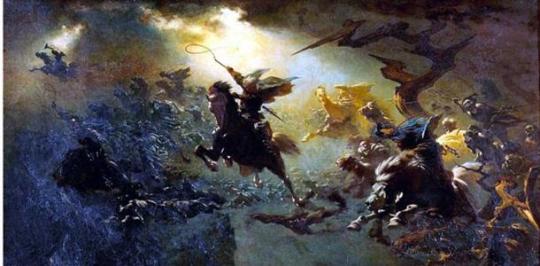
^Johann Wilhelm Cordes: Die Wilde Jagd (The Wild Hunt)1856/57
Pan
The conflation of Pan with Cernunnos appears to be predominantly based in the view of all male horned deities being simple aspects of a larger presence – the Wiccan Horned God. As previously stated, I do not support that concept and will use this section to study Pan as a separate entity and cover where in my UPG they overlap.
Pan is the Greek god of the wilds, music, and a guardian of shepherds and their flocks. He also was usually in the presence of nymphs.[13] Unlike the Stag depictions and associations of Cernunnos, Pan sported the legs and horns of a goat and appeared similar to a Satyr. His domain expanded to agricultural and wooded areas, as well as the realms of sex and fertility. The sum of those parts was to present him as a god of the season of Spring. He had a Roman equivalent in the god Faunus, and was also conflated with another known as Silvanus at times. Pan became a popular god during the 20th century neopagan revival[14].
Even before that, worship of him was brought back by a festival originating in Painswick, Gloucestershire by Benjamin Hyett, who also constructed various holy places in the god’s name.[15] Other popular occultists of the early 1900’s such as Aleister Crowley also crossed paths with Pan, as he built an altar to the god and wrote a ritual play about him.[16] After that point, his image and general description was absorbed into the Wiccan Horned God concept after Margaret Murray’s The God of the Witches posed the idea that he was simply one part of an overarching whole.
But who was Pan outside of this, particularly who was he before the Witch-god hypothesis altered how future generations would see him?
Pan is considered by some scholars to be a reconstruction of a Proto-Indo-European pastoral deity[17], as well as Pushan, a god originating from Rigvedic that also shared goat traits.[18]
Beyond these source hypotheses, there is evidence that Pan was first worshipped in the mountainous, isolated area of Arcadia. In that area, if a hunt wasn’t satisfactory, disgruntled hunters would scourge, or whip, the statue of Pan.[19] At this time, there were no formal temples to Pan, and worship was instead pursued in woodlands and other natural spaces. While exemptions from this rule did exist, they were few and far between.[20] He predates the Olympians, like many Grecian nature spirits. I won’t go too in depth regarding direct mythology, as its difficult to do that with the Greek pantheon without tangents.
Pan was viewed as a height of sexual prowess, and agricultural success. He had a history of dalliances with Nymphs, to put it lightly, often depicted as being controlled by his lust and anger. Such as in the myth of the Nymph Echo, whom he ordered killed when she denied any man. In some versions, the pair even have two children, or perhaps chose Narcissus over him, no matter the variation he is usually painted as rash and jealous. I’m sure we’ve all seen that statue of Pan and the goat that resides in the National Archaeological Museum in Naples.
The word “panic” can trace its sources back to him, but I was surprised to find that “pandemonium” does not.[21]
In my personal view, Cernunnos ages with the seasons, being at his most virile in the Spring, then maturing into his form as a guardian of the dead come winter, appearing dead himself. This is relevant in that I find the depictions of the lustful, energetic Pan to be inspiring of how I see that Spring form. Beyond that, the agricultural and animal connections are similar, but seem to take very different forms upon closer inspection.
Within actual historical context, there doesn’t seem to be anything connecting Cernunnos and Pan in any way beyond neo-pagan labelling.
[13] Edwin L. Brown, "The Lycidas of Theocritus Idyll 7", Harvard Studies in Classical Philology, 1981:59–100.
[14] The Triumph of the Moon: A History of Modern Pagan Witchcraft, Hutton, Ronald, chapter 3
[15] Hutton, Ronald. The Triumph of the Moon: A History of Modern Pagan Witchcraft pp 161–162.
[16] Soar, Katy (2020). "The Great Pan in Albion". Hellebore. 2 (The Wild Gods Issue): 14–27.
[17] Mallory, J. P.; Adams, D. Q. (2006). The Oxford Introduction to Proto-Indo-European and the Proto-Indo-European World. Oxford, England: Oxford University Press. p. 434
[18] H. Collitz, "Wodan, Hermes und Pushan," Festskrift tillägnad Hugo Pipping pȧ hans sextioȧrsdag den 5 November 1924 1924, pp 574–587.
[19] Theocritus. vii. 107
[20] Horbury, William (1992). Jewish Inscriptions of Graeco-Roman Egypt. Cambridge, England: Cambridge University Press. p. 208.
[21] Coined by John Milton in his poem “Paradise Lost” coming from the Greek pan- “all” and daemonium “evil spirit”
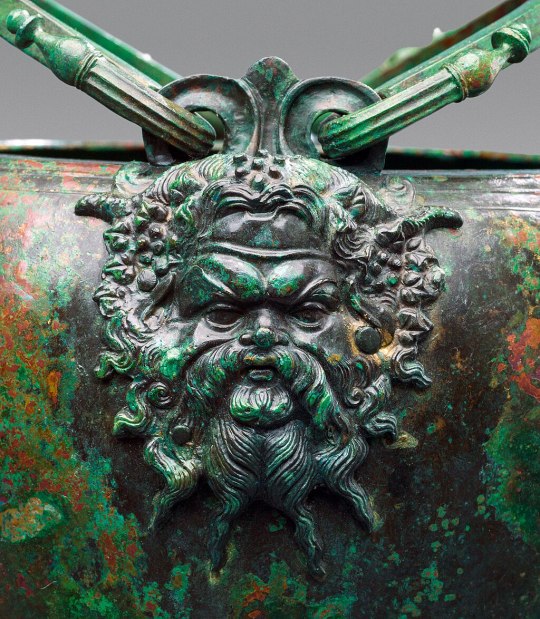
^Mask of the god Pan, detail from a bronze stamnoid situla, 340–320 BC, part of the Vassil Bojkov Collection, Sofia, Bulgaria (It is shockingly difficult to find art of Pan where he's not rock hard.)
The Green Man
Viewed as more of a motif or concept than a deity, the Green Man originated in England and was usually depicted as covered in leaves and sometimes armed with a club. One might encounter these visuals in parades, festivals, or painted on the signs of many pubs come the 17th century. This changed with the introduction of Julia Somerset, who claimed in the Folklore journal that the design often seen on church walls actually had pagan origins as some kind of fertility deity.[22] There is no evidence to support this claim, and it has been contested by many folklorists.[23] This assertion by Somerset was then absorbed into the Wiccan Horned God despite being described as distinctly “20th Century Folklore”.[24]
That’s pretty much the extent of this one and was honestly one of the most shocking to read about. The Green Man was at best a regional icon used in local festivities but was never any kind of deity. That title was misrepresented and incorporated without research.
My personal association would be the visuals of Winter, but Cernunnos’ Winter form appears very differently to me. More skeletal stag, less old man with a holly beard.
[22] Centerwall, Brandon S. (January 1997). "The Name of the Green Man". Folklore. 108 (1–2): 25–33.
[23] Livingstone, Josephine (2016-03-07). "The Remarkable Persistence of the Green Man". The New Yorker.
[24] Olmstead, Molly (2023-04-08). "Is the Green Man British Enough for the Royal Coronation?". Slate.
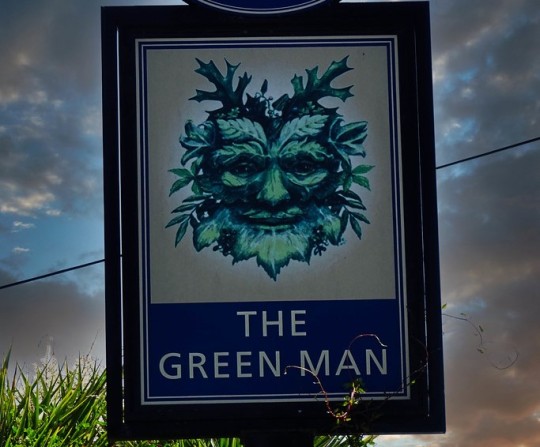
^A sign for the John Barras Pub Company
Herne the Hunter
After the last section, it is a relief to move on to something that has always been presented to me with its original fictional context intact. Herne the Hunter was a character originally depicted in The Merry Wive of Windsor written by Shakespeare in approximately 1597. Supposedly, Herne the Hunter is an antlered spirit that occupies the Royal Forest in England, occupying himself with tormenting cattle and rattling chains. While the character may have been based on local legends to some degree, it is unknown just how much verifiable connection has ever existed. Attempts to connection him to other deities or legends were made often after he was written.
There is an old tale goes, that Herne the Hunter
(sometime a keeper here in Windsor Forest)
Doth all the winter-time, at still midnight
Walk round about an oak, with great ragg'd horns;
And there he blasts the tree, and takes the cattle,
And makes milch-kine yield blood, and shakes a chain
In a most hideous and dreadful manner.
You have heard of such a spirit, and well you know
The superstitious idle-headed eld
Receiv'd, and did deliver to our age
This tale of Herne the Hunter for a truth.
— William Shakespeare, The Merry Wives of Windsor, Act 4, scene 4
Despite Herne being a location-based character appearing only in the areas Windsor Forest occupied, certain books published in 1929 and 1933[25] attempted to identify him with Cernunnos and other horned deities. This is again the connection through which Wiccans incorporated Herne into the Horned God.[26]
[25] The History of the Devil – The Horned God of the West by R. Lowe Thompson; The God of the Witches by Margaret Murray
[26] 'Simple Wicca: A simple wisdom book' by Michele Morgan, Conari, 2000

^Illustration of Herne the Hunter by George Cruikshank (1840s)
Romanizations
There are theories mentioned in mask131’s essay regarding attempts at identifying what Roman deity or deities was meant to be the equivalent of Cernunnos, but there is sadly only speculation on that front. Opinions vary from person to person, but parallels are often drawn to Dis Pater and Mercury for shared traits. I did find instances such as the Lyon Cup and an altar from Reims that feature Mercury and Cernunnos depicted side by side, so I believe it is safe to say that they were at least at some point considered fully separate beings.

^1st-century CE altar from Reims with Cernunnos, accompanied by Apollo and Mercury. Mercury has a cornucopia, while Cernunnos spills grain.
Aside – Misinformation is Rampant
This one book, this one fucking “hypothesis”, changed the entire face of what would eventually become modern neopaganism. The damage of the Witch-cult hypothesis is far reaching and permeates every resource I could find while writing this piece aside from the explicitly scholarly. It is extremely discouraging how quickly you can trace something that feels off back to this one woman’s massively disproven theory that was adopted by a man that wanted to make a religion based on occult foundations because he admired ceremonial magic. The frustration I feel as someone trying to do research now after this misinformation and pseudohistory has seeped into every aspect of the path has me constantly on edge and second guessing everything I read until I can find a source.
Stating UPG as undeniable fact that others must agree with isn’t great at the best of times, but the sheer level of ignorance to historical record seems to be running rampant within the modern Pagan community. I’m all for believing something unverifiable, something that’s only true for you, or for the world from your perspective, but there is and must be a difference between that and presenting easily disproven statements as unbreakable law, especially with they come hand in hand with any dressings like, “this is actually true because I was told so by this person, who learned from this other person.” And the process is traceable to the source they borrowed from and how it was completely disproven.
We must think critically within paganism, research beyond the books with flashy covers in Barnes & Noble and question the things we are told by others are just the way things are.
Your relationship with the gods is yours alone and can take any form you want it to. Don’t let yourself be trapped by ignorance. Learn about historical contexts, question sources, seeking mentoring from those who revel in your questions and help you find the answers.
Conclusion
Cernunnos is a deity that is beyond valuable to communicate with directly due to the lack of concrete historical and folkloric information, and the prevalence of blatant misinformation that uses his name. Context is important, and even if you choose to exist outside of it, which is a perfectly valid choice, it should be a conscious one.
In addition, while attempting to research this, I actually stumbled upon sites not just with AI generated cover images, but what fully appeared to be AI generated writing. Be vigilant against information that looks like someone just skimmed the surface and made an assumption, this page had a lot of almost correct or just flat out made up information that contradicts historical fact. Especially in this modern era where people use automatic programs to make summaries of summaries for a game of unverifiable internet telephone, be aware. No matter what your personal stance on AI is, I'm sure we can all stand against information atrophy.
To me, Cernunnos is a supportive, ever-present god that helps me through things in his own way, meaning that its usually something intense and then coming out the other side putting out a fire on the back of my head. He's hands-off, and wants me to admire the turning of the seasons from new angles. He's opened my eyes to a deeper respect for other belief systems, and encouraged me to do this research so that I could better understand him as well as our own connection. He wants me to be observant and always keep learning and questioning and growing in my faith, in my magic, in my role as a faery.
When it comes to the belief systems that you rely on in life, ignorance is not bliss. Seek knowledge deep in the forest and on the frozen boundaries of a lake or standing barefoot in a grassy meadow, but also in historical records. Anyone who wants the best for you will want you to research and learn more.
Genuinely as I was finishing this up last night, adding this section to the post version the next morning, I considered becoming a YouTube essay person. Maybe someday! Perhaps an actual blog. Researching and writing this kind of thing was actually very fun. I never even did something like this while I was in school, so maybe I'm just not traumatized by the concept. Anyways, I hope this was informative and you enjoyed a peek into the journey I took while putting this together.
Now I'm gonna go light up some green in dedication to Cernunnos ✌︎︎♡⃛
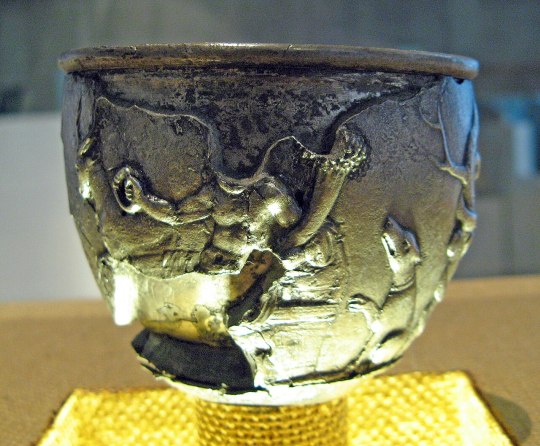
^The Lyon Cup, sometimes identified as Cernunnos
#witch#witchcraft#magic#witchblr#witchy#me#pagan#personal#cernunnos#celtic paganism#paganism#herne the hunter#pan#the green man#wild hunt#fae#fairy#faekin#fae kin#the horned god#wicca#margaret murray#witch-cult hypothesis#gerald gardner#wiccan#history#folklore#essay#advwitchblr#grownasswitches
37 notes
·
View notes